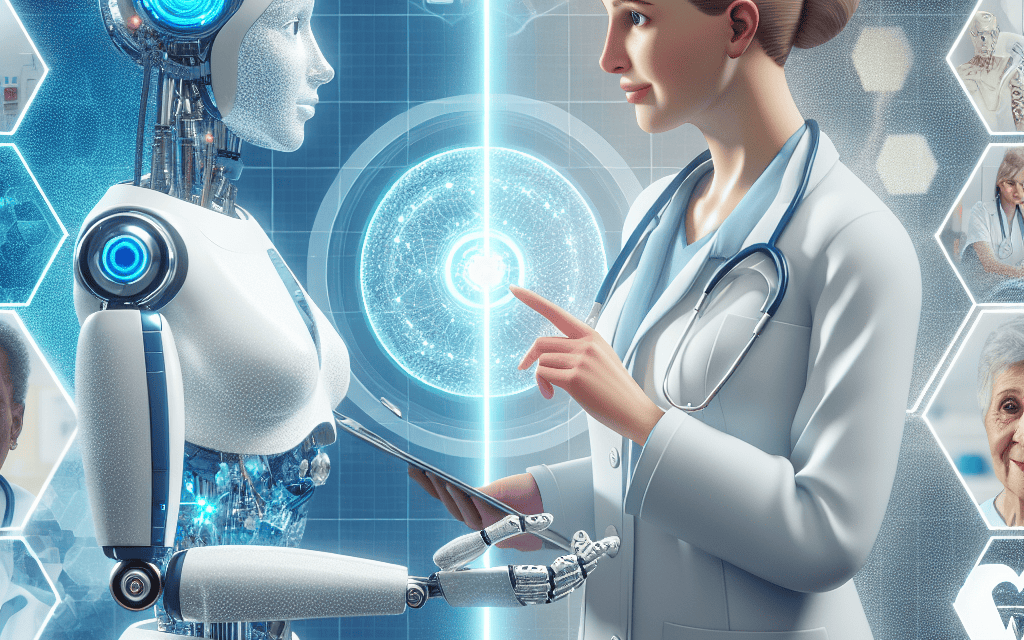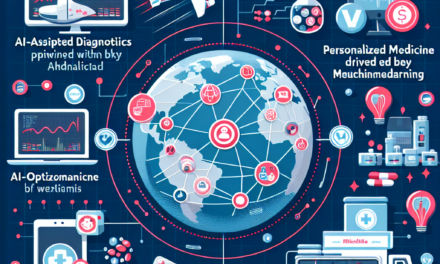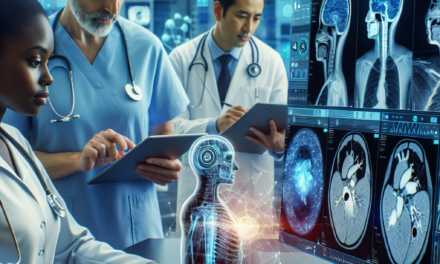Enhancing Healthcare with AI: Balancing Technology and Humanity
The integration of Artificial Intelligence (AI) into healthcare is transforming the landscape of medical practice, patient care, and health management. As technology advances, the potential for AI to enhance healthcare delivery becomes increasingly evident. However, this transformation raises critical questions about the balance between technological innovation and the essential human elements of care. This article explores the multifaceted role of AI in healthcare, examining its benefits, challenges, and the need for a harmonious relationship between technology and humanity.
1. The Role of AI in Diagnostics
AI has made significant strides in the field of diagnostics, where its ability to analyze vast amounts of data quickly and accurately can lead to earlier and more precise disease detection. Machine learning algorithms, particularly those trained on large datasets, can identify patterns that may be invisible to the human eye.
1.1 Machine Learning in Radiology
One of the most prominent applications of AI in diagnostics is in radiology. AI algorithms can analyze medical images such as X-rays, MRIs, and CT scans to detect anomalies. For instance, a study published in the journal *Nature* demonstrated that an AI system could outperform radiologists in identifying breast cancer in mammograms. The AI system achieved a reduction in false positives and false negatives, leading to improved diagnostic accuracy.
- AI systems can process images at a speed and scale that far exceeds human capabilities.
- They can be trained on diverse datasets, allowing them to recognize a wide range of conditions.
- AI can assist radiologists by flagging potential issues, allowing for more efficient use of their time.
However, the reliance on AI in diagnostics raises concerns about over-reliance on technology. While AI can enhance accuracy, it is crucial that human expertise remains central to the diagnostic process. Radiologists must interpret AI findings and consider the patient’s overall clinical context.
1.2 Pathology and AI
In pathology, AI is being used to analyze tissue samples and identify cancerous cells. Algorithms can assess histopathological images, providing pathologists with valuable insights. A notable example is PathAI, a company that uses machine learning to improve the accuracy of pathology diagnoses. Their technology has shown promise in identifying various types of cancer, significantly reducing diagnostic errors.
- AI can enhance the speed of pathology reports, allowing for quicker treatment decisions.
- It can assist in identifying rare diseases that may be overlooked by human pathologists.
- AI systems can learn from new data, continuously improving their diagnostic capabilities.
Despite these advancements, the integration of AI in pathology must be approached with caution. Ethical considerations, such as data privacy and the potential for bias in AI algorithms, must be addressed to ensure equitable healthcare outcomes.
2. AI in Personalized Medicine
Personalized medicine aims to tailor medical treatment to the individual characteristics of each patient. AI plays a crucial role in this approach by analyzing genetic, environmental, and lifestyle factors to develop customized treatment plans.
2.1 Genomic Data Analysis
AI algorithms can process vast amounts of genomic data, identifying mutations and variations that may influence disease susceptibility and treatment response. For example, companies like 23andMe and AncestryDNA use AI to analyze genetic data, providing insights into health risks and potential preventive measures.
- AI can identify patterns in genetic data that may indicate predispositions to certain diseases.
- It can help in selecting targeted therapies based on a patient’s genetic makeup.
- AI can facilitate drug discovery by predicting how different genetic profiles respond to various compounds.
However, the use of genomic data raises ethical concerns regarding privacy and consent. Patients must be informed about how their data will be used and the potential implications of genetic testing.
2.2 Predictive Analytics in Treatment
AI-driven predictive analytics can forecast patient outcomes based on historical data. For instance, hospitals are using AI to predict which patients are at risk of readmission, allowing for proactive interventions. A study published in *Health Affairs* found that AI models could predict hospital readmissions with an accuracy of up to 80%.
- Predictive analytics can help healthcare providers allocate resources more effectively.
- They can identify patients who may benefit from additional support or follow-up care.
- AI can assist in managing chronic diseases by predicting flare-ups and suggesting preventive measures.
While predictive analytics offers significant benefits, it is essential to ensure that these models are transparent and interpretable. Healthcare providers must understand the rationale behind AI predictions to make informed decisions about patient care.
3. Enhancing Patient Engagement with AI
AI technologies are also being leveraged to enhance patient engagement, improving communication and fostering a more collaborative healthcare experience. By utilizing AI-driven tools, healthcare providers can empower patients to take an active role in their health management.
3.1 Virtual Health Assistants
Virtual health assistants, powered by AI, can provide patients with personalized health information and support. These chatbots can answer questions, schedule appointments, and provide medication reminders. For example, the chatbot developed by Buoy Health uses AI to guide patients through their symptoms and recommend appropriate care options.
- Virtual assistants can improve access to healthcare information, especially for underserved populations.
- They can reduce the burden on healthcare providers by handling routine inquiries.
- AI-driven tools can provide 24/7 support, enhancing patient satisfaction.
However, while virtual health assistants can enhance patient engagement, they should not replace human interaction. Patients may still require the empathy and understanding that only a human provider can offer, particularly in sensitive situations.
3.2 Telemedicine and AI
The COVID-19 pandemic accelerated the adoption of telemedicine, and AI is playing a vital role in this transformation. AI algorithms can analyze patient data during virtual consultations, providing healthcare providers with real-time insights. For instance, AI can assist in triaging patients based on their symptoms, ensuring that those who need immediate care receive it promptly.
- Telemedicine can increase access to healthcare services, particularly in rural areas.
- AI can enhance the efficiency of virtual consultations by streamlining data analysis.
- Patients can receive timely interventions without the need for in-person visits.
Despite the benefits of telemedicine, challenges remain, including issues related to technology access and the need for robust cybersecurity measures to protect patient data.
4. Ethical Considerations in AI Healthcare Applications
The integration of AI into healthcare raises significant ethical considerations that must be addressed to ensure responsible use of technology. As AI systems become more prevalent, it is essential to establish guidelines that prioritize patient welfare and equity.
4.1 Data Privacy and Security
AI systems rely on vast amounts of data to function effectively, raising concerns about data privacy and security. Healthcare organizations must implement stringent measures to protect patient information from breaches and unauthorized access. The Health Insurance Portability and Accountability Act (HIPAA) in the United States sets standards for protecting sensitive patient data, but compliance remains a challenge for many organizations.
- Healthcare providers must ensure that AI systems comply with data protection regulations.
- Patients should be informed about how their data will be used and stored.
- Robust cybersecurity measures are essential to prevent data breaches.
Failure to address data privacy concerns can erode patient trust and hinder the adoption of AI technologies in healthcare.
4.2 Bias and Fairness in AI Algorithms
AI algorithms can inadvertently perpetuate biases present in the training data, leading to disparities in healthcare outcomes. For example, a study published in *Science* found that an AI algorithm used in dermatology was less accurate in diagnosing skin conditions in individuals with darker skin tones. This highlights the importance of ensuring that AI systems are trained on diverse datasets to avoid reinforcing existing inequalities.
- Developers must prioritize diversity in training datasets to ensure equitable outcomes.
- Regular audits of AI systems can help identify and mitigate biases.
- Collaboration with diverse stakeholders can enhance the development of fair AI solutions.
Addressing bias in AI is crucial for building trust and ensuring that all patients receive equitable care.
5. The Future of AI in Healthcare: A Human-Centric Approach
The future of AI in healthcare lies in a human-centric approach that prioritizes the well-being of patients while harnessing the power of technology. As AI continues to evolve, it is essential to strike a balance between innovation and the human touch that defines quality healthcare.
5.1 Collaborative Care Models
AI should be viewed as a tool that complements human expertise rather than a replacement for it. Collaborative care models that integrate AI into the healthcare team can enhance decision-making and improve patient outcomes. For instance, AI can assist physicians in diagnosing complex cases, while healthcare providers can offer the empathy and understanding that patients need.
- AI can provide data-driven insights to support clinical decision-making.
- Healthcare providers can focus on building relationships with patients, enhancing trust and communication.
- Collaboration between AI and human providers can lead to more comprehensive care plans.
By fostering collaboration between technology and healthcare professionals, the industry can create a more effective and compassionate healthcare system.
5.2 Continuous Learning and Adaptation
The healthcare landscape is constantly evolving, and AI systems must be designed to adapt to new information and changing patient needs. Continuous learning algorithms can improve their performance over time, ensuring that they remain relevant and effective. For example, AI systems used in clinical trials can analyze real-time data to identify trends and adjust treatment protocols accordingly.
- AI systems should be regularly updated with new data to enhance their accuracy.
- Healthcare providers should receive ongoing training to effectively integrate AI into their practice.
- Feedback loops between AI systems and healthcare professionals can drive improvements in care delivery.
By embracing a culture of continuous learning, the healthcare industry can harness the full potential of AI while maintaining a focus on patient-centered care.
Conclusion
The integration of AI into healthcare presents both opportunities and challenges. While AI has the potential to enhance diagnostics, personalize medicine, and improve patient engagement, it is essential to address ethical considerations and ensure that technology complements the human elements of care. A balanced approach that prioritizes collaboration between AI and healthcare professionals will lead to better patient outcomes and a more equitable healthcare system.
As we move forward, it is crucial to foster a culture of innovation that embraces technology while recognizing the irreplaceable value of human compassion and understanding in healthcare. By doing so, we can create a future where AI enhances healthcare delivery without compromising the humanity that lies at its core.





